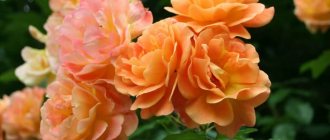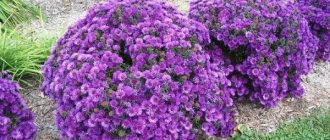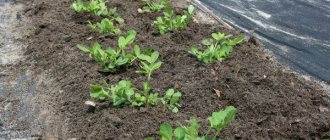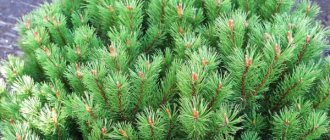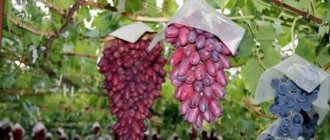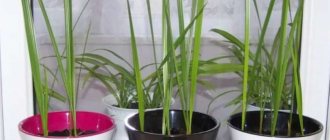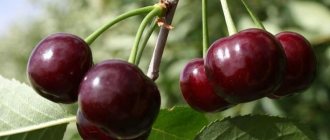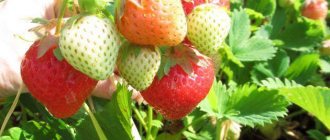“Russian sage” is how the perennial Perovskia is known throughout the world. The plant is really similar in appearance to sage - beautiful blue buds on green foliage, size, height.
The name “Perovskia”, unusual even for Russian ears, was given in honor of the governor of the Orenburg region, whose last name was Perovsky. He probably loved this plant very much. But, looking at Perovsky, it seems that his fields were planted with it from top to bottom.
Fragrant blue sea of blooming Perovskia
It is no coincidence that Perovskia is known throughout the world under the name “Russian sage”. The appearance of this beauty really resembles both sage and wormwood, and the plant itself can be put on a par with the best blue-flowered perennials.
Perovskia is a genus of plants of the Lamiaceae family, named after the governor of the Orenburg province Vasily Alekseevich Perovsky (1795-1857).
Perovskia, or Russian sage, is a herbaceous perennial that has equally attractive clumps and flowers. Although this plant is mostly appreciated for its long and colorful flowering. The bushes reach a height of 60 cm, and sometimes 1 m. The shoots are numerous, thin and straight, hard, stable. Perovsky leaves are narrow-lanceolate or dissected, always elongated in shape, dark muted color.
The flowers of the plant are very small and would be inconspicuous if it were not for the slender panicles of the inflorescences and the cool, bluish-purple color, which gives the clumps a special showiness. Thanks to its color, this plant is considered one of the best crops for simulating water, creating the effect of blue coolness and swaying waves in the garden. The Perov bushes really seem to be shrouded in blue fog.
All parts of the plant are very fragrant, but Perovskaya is valued not only as a source of essential oils and a wonderful fragrant dried flower. After all, both the flowers and leaves of the plant are edible and can be used both as a seasoning and in cooking a wide variety of dishes.
Flowering of Perovskia continues from July until the very first autumn frosts. At the same time, unlike its long-term competitors, Perovskia blooms tirelessly.
Perovskia swanfolia. © qooh88
Perovskia swan-leaved, description of the plant
This species belongs to the genus of plants called “Perovskia” from the Yasnotkovy family. The unusual and difficult to perceive name of the genus was assigned in honor of the Orenburg governor V.A. Perovsky. Often, abroad, the plant is also called “Russian sage” due to the external similarity of perennials and the typical musky aroma.
Externally, Perovskia resembles mountain herbs such as lavender or wormwood. At the same time, it is a relative of other aromatic plants: mint, sage, oregano.
- The homeland of Perovsky swan leaf is considered to be the territory of Central and South-West Asia, where the subshrub can be found in the steppes, rocky areas or dry forests. The sharply continental climate and depleted soils of Asia allowed the formation of high endurance, drought resistance and unpretentiousness of a perennial flowering subshrub.
- Perovskia is a fairly tall subshrub, densely planted with violet-blue flowers. The height of the plant, on average, varies from 50 to 100 cm. Although, under favorable conditions, semi-lignified clumps can grow up to 1.5 meters.
- The blue-colored perennial, Perovskia swan-leaved, has a particularly attractive decorative appearance during its long flowering period. Although voluminous evergreen, with a shade of silver, curtains look no less impressive even without flowers.
- The whitish-gray shoots, forming a loose clump, are hard, straight and numerous. At the base, the stems gradually become woody, and after annual pruning, the plant “produces” new young shoots.
- The oppositely arranged, rugged leaves have an elongated elongated shape, a muted green-silver color and are covered with light pubescence. Due to this, Perovskia bushes have an unusual bluish tint and a velvety texture that is pleasant to the touch.
- The perennial's purple flowers are small, collected in dense panicle inflorescences. Due to this, the impression of airiness of a blue cloud of numerous delicate flowers framing the bush is created.
- The shrub blooms for a long time and continuously: from July to November, until the first frost.
- Perovskia swanfolia contains a number of essential oils, thanks to which all parts of the plant retain a subtle spicy, slightly minty and nutmeg aroma for a long time.
- Fragrant beautiful twigs of Perovskia are also used as long-lasting dried flowers or when decorating dry bouquets.
- The dried parts of the aromatic culture have found their use even in cooking, as a fragrant and refreshing seasoning.
Types and varieties of Perovskia
There are not many plants in the Perovsky genus: Russian sage includes only 7 species. At the same time, only two Perovskias are grown as ornamental plants.
Perovskia wormwood (Perovskia abrotanoides) is a herbaceous perennial with a height of 40 to 120 cm, which from a distance seems to be a relative of lavender. The plant forms round, neat and very dense bushes. The shoots are densely leafed with strongly dissected, oblong leaves. The dark blue color with a lilac tint of small flowers in the spikes of inflorescences crowning the branches creates a spectacular haze over the turf.
Perovskia atriplicifolia with semi-lignified shoots belongs to the perennial subshrubs. This plant is much taller, from 90 cm to one and a half meters in height. The shoots are gray, grow upright, very thin, and the leaves appear silver and give the whole plant a metallic velvety texture. The crowning shoots of the inflorescence reach 30 cm in length, more loose than those of most other species. Outwardly it seems more massive and graceful at the same time.
Perovskia wormwood (Perovskia abrotanoides). © bomennederland
Perovskia: Russian sage with lavender blooms
The interesting and non-standard name of this plant - Perovskia (Latin: Perowskia) has its own little history. It is named after General V. A. Perovsky, a hero of the 1912 war. It was he who discovered this subshrub in Central Asia, and his interest in botany was far from accidental: the general’s father created one of the first professional botanical gardens in the country. Thus, the beautiful plant gradually filled not only Russian gardens, but also European ones.
Perovskia, planting and caring for which, like other perennials that coexist next to it in the gardens (speedwell, lavender, catnip, sage), is not difficult. This plant is loved by those who prefer to admire mountain and steppe plants; its beautiful whitish stems, silvery foliage and flowering panicles of lavender color look very impressive.
Common types and varieties of Perovskia with photographs
The most common types of Perovskia in our country are the swan-leaved varieties (Latin: Perovskia atriplicifolia) and wormwood (Latin: P.abrotonoides). Based on these two species, the most popular varieties have been bred, such as “Blue Spire” and “Lacey Blue”, as well as “Filigran”.
Perovskia wormwood
It is also called Perovskia abrotanoides (Latin: Perovskia abrotanoides), it got its name in Latin from medicinal wormwood, which it resembles not only in smell, but also in appearance. The plant grows wild in the mountainous regions of Turkmenistan and Tien Shan, as well as in Afghanistan, eastern Iran and Tibet. It is also found in the northern part of India.
The subshrub loves rocky slopes; it grows up to a meter in height. The plant has highly branched stems, long, silvery leaves covered with small hairs. Wormwood Perovskia blooms very beautifully, with large panicles, up to forty centimeters in length. The small flowers have a bell-shaped calyx and are densely covered with short white and purple hairs. The corolla is lilac, sometimes purple, and in rare cases white. The plant blooms in June and pleases gardeners until the very end of August.
Perovskia wormwood in the photo
Perovskia swanfolia
In another way, this species is called Pamir (Latin: Perovskia atriplicifolia). In the wild, the plant grows on rocky slopes in China and Afghanistan, as well as in northern India and Pakistan. In the West it is sometimes called Azure sage.
The plant can grow over a meter in height and from a distance it looks very similar to Lavender. Her bush is the same - neat, round and dense. All shoots are completely covered with leaves; they are oblong and dissected in shape. During flowering, the plant is very beautiful: blue-lilac small flowers in spikes of large inflorescences.
Many varieties of this species differ in different shapes and sizes of leaves and flowers, their flowering time, and different frost resistance.
Perovskia swan-leaved in the photo
The last indicator should be kept in mind when choosing a variety, especially if you live in a region with cold winters:
- The Filigran variety can reach a height of almost a meter. The peculiarity of this variety is its growth is purely vertical, the foliage is bluish in color. Filigree blooms longer than other varieties.
- The Blue Spire variety can grow up to 1.2 meters tall, has bright purple flowers and heavily rugged foliage. Flowering continues from June until September, and in warm regions until October.
- The Blue Mist variety is distinguished by its delicate light blue flowers. This variety is the first to bloom.
- Lacey Blue is a low bush, it does not grow more than half a meter, but it has large flowers. Good for alpine slides and rocky gardens.
- The Silvery Blue variety is also low (up to 0.6 meters), it has a very beautiful silver shade of leaves. Blue flowers bloom in early August and bloom until early October.
- The Taiga variety blooms with light blue flowers and grows half a meter in height. Blooms in August – September. This variety is distinguished by its ability to tolerate frosts above thirty degrees, hence the name.
- The Longin variety is distinguished by its large height (up to 1.2 meters), it has vertically growing stems and slightly dissected leaves of gray-green color with a silvery tint. The variety was named in honor of Longinus Ziegler, who bred it in Switzerland.
Perovskia hybrid in the photo
https://www.youtube.com/watch?v=xCycrusOV4U
In the gardens of Great Britain you can find Perovskia hybrida (Latin: Perovskia x hybrida); it was first discovered in Kyrgyzstan. This Perovskia is a hybrid of wormwood and swan-leaved species. It has green-blue oval leaves with teeth and dark purple flowers that begin to bloom in late summer.
Planting, propagation and care
First of all, it is important to know when to sow seeds: in open ground in late autumn (before winter). However, you can plant plants in the spring, after sowing seedlings. Before sowing, the seeds need to be stratified for a month (put them in the refrigerator). This will speed up germination, otherwise the process will last up to 12 weeks, and the seedlings will be weak. Growing from seeds is very advisable: plants already in the first year grow to the height of an adult plant, however, they bloom only in the third year, and sometimes later.
Planting and caring for Perovskia is a common procedure: holes or rows are made (if a lot of plants are planted). Before planting, prepare the soil; add sand and compost to it, and then carefully dig up the soil. The seedlings need to be planted together with a ball of earth. Immediately after planting, young plants should be watered regularly for some time.
Perovskia seedlings are grown in containers and planted in open ground in the spring, after the soil has warmed up.
Varieties of swan-leaved Perovskia have to be propagated not by seeds, but vegetatively, by cuttings . If cuttings are planted, this should be done in early June. In early spring, a lignified shoot of the plant is taken for cuttings, and in the summer, cuttings with pieces of rhizomes are cut.
The cuttings should be planted in slightly moist soil in a small greenhouse. We must not forget about good drainage. The temperature on the soil should be about twenty degrees plus.
It is better to ventilate the greenhouse occasionally to avoid condensation, which can cause rotting that is dangerous for young plants.
The roots appear no earlier than on the tenth day; at this time, Perovskia needs to be fed with mineral fertilizers, but in small quantities. Before the plant adapts to it, you need to pay close attention, but then there will be no problems with caring for Perovsky. Perovsky is not at all afraid of transplantation, but it can grow well in one place even for decades.
The main point for the successful cultivation of this mountain plant is to arrange conditions for it that will be close to natural in its habitat. You should remember its homeland: the plant loves bright sun, light alkaline (not acidic) soil and normal drainage. Excess nitrogen is harmful to the plant.
Watering the plant
Perovskia does not need abundant watering.
Perovskia should not be watered abundantly. True, on hot, dry days you should not refrain from watering, but you must always remember that the plant may die from stagnation of water at the roots. Perovskias thrive on rocky and poor soils in open ground, however, for abundant flowering, sometimes they can be fed with mineral fertilizer (half the dose).
As mentioned above, you should be careful when watering: water should not flood the base of the shoots. If it rains heavily and the soil is excessively moist, you need to do mulching, drainage, and additional loosening. Excess moisture must be removed by any means.
Interesting. The smell of blooming Perovskia actively attracts pollinating insects. The plant is considered medicinal; just like lavender, which it is so similar to, it relieves stress and depression, has antiviral and anti-inflammatory properties, and is good for the cardiovascular system.
In early spring, the plant needs to be cut to a height of about ten centimeters from the ground. Afterwards you can lightly compact it and mulch it with fine gravel. In the fall, after flowering, Perovskia does not need to be pruned; its gray shoots will decorate the garden in winter.
Preparing for winter
Perovskia is a winter-hardy plant; wormwood can withstand even 25 degrees below zero. Although there are varieties in the culture that do not tolerate cold well. However, for the winter the plant can be covered with a mixture of sand and wood ash. You can add a glass of ash to a bucket of sand.
Important. The shelter should only be dry; waterlogging in cold weather will destroy the plant.
True, after freezing, Perovskia can be easily restored from the root. In the Moscow region, in the Leningrad region and in central Russia, the plant can grow without shelter, however, the weather in recent years has been giving us surprises, so it’s better to play it safe.
Perovskia tolerates frost quite well, but some varieties need to be covered.
Diseases and pests of Perovsky
Perovskias are not susceptible to pest infestation and rarely get sick. All problems in a plant can arise either from waterlogging or from acidic soil. The essential oil that these plants produce has insecticidal properties and can repel pests. True, in rare cases, Perovskia is attacked by aphids, and if the plant is in closed ground, it can be affected by spider mites or whiteflies.
Perovsky in landscape design
In any garden, this plant can be used for planting as a single plant, as well as as a background or background for any composition. Perovsky goes well and gets along well with all plants that like to grow in alkaline soil. This is not only sage and wormwood, but also various grains. Perovskia looks great next to yarrow.
Advice. Perovskie pair beautifully with roses. It can create a background for them, and it will also help get rid of aphids.
It is advisable to plant short varieties in mixborders, use them in borders, and also as one of the elements of the composition of a rocky garden or alpine hill. You can also use it as a low hedge. Perovskia looks great in a flower garden that is covered with stone mulch.
In the video, flower growers show the Perovskia plant and talk about the care and cultivation of these flowers.
The herb of the plant can be used in food as a spice and to flavor drinks. The flowers, in addition to their strong aroma, also have a sweetish, pleasant taste, which makes it an excellent opportunity to use them in salads, add them to baked goods, and decorate various dishes with them.
A beautiful plant with silver foliage and bright inflorescences will decorate any garden plot. The British called this plant Russian sage, which translates as Russian sage. Indeed, although Perovskia grows in Asia, it was discovered by a Russian lover of botany, and lives in our gardens as a beloved and honored guest.
Source: https://cveti-rasteniya.ru/perovskiya-posadka-i-uxod.html
Categories Landing
Use of Perovski in ornamental gardening
- Only in groups of 3-5 copies, never placing plants alone, even in flower beds;
- for creating low hedges;
- in curbs;
- as a delimiter between zones in the garden or a “pointed”, dotted border;
- for placing geometric accents, arranging large sods in “dots” or “chessboards”;
- in the design of flat rockeries and the foot of an alpine hill;
- in flower beds with decorative soil covering (especially stone mulch);
- as accents that are attractive in winter;
- for textural contrasts and creating dense vertical points of attraction for the eye;
- in the design of modern gardens with a focus on metallic effects, water allusions and unusual textures;
- as a vertical structuring accent in double-sided mixborders and borders.
The best partners for Perovskia: roses, ornamental grasses, echinacea, liatris, boltonia, mallow.
Application in landscape design
Perovskia is highly decorative and can be used beautifully in landscape design, both independently, as a single planting, and in compositions with other plants in flower beds. In mixed flower beds, Perovskia has many options for solving compositions. Pairs well with plants that have bright flowers in shades of pink, orange, red and yellow.
- An interesting combination - Perovsky and roses . Vertically stretched stems of Perovskia, strewn with the “pollen” of soft purple flowers, will harmoniously heal both with roses that have bright and large flowers, and with small, delicate shades.
- The lush inflorescences of yarrow harmonize beautifully with the “web” of stems and flowers of Perovskia, the photo below conveys this quite well. This composition will be a beautiful decoration for any area.
- What about a composition of Perovsky and cereal crops? It looks very discreet and decorative! Delicate shades of purple and the color of cereals create a pleasant soft combination.
Tall varieties will be an excellent pair for almost any perennial plants, such as echinacea, poppy, wormwood, asters, yarrow, calendula. Perovskia also looks great together with mallow, lavatera, katran, limonium, and liatris. Also, the silver-whitish foliage and soft purple flowers add a beautiful accent to flower beds or become an excellent background for other plants.
Perovskia also independently decorates the exterior space in the form of mass plantings; they look especially impressive along paths and alleys.
Taking into account the natural habitat of Perovskia, it can be planted in gravel and rocky places, on dry, hot slopes. Drought resistance makes it possible to use this plant in container compositions.
Speaking about the use of Perovskia in landscape architecture of the urban environment, for example, in Moscow this plant is part of the flower beds of Gorky Park.
Conditions required by Perovskys
Perovskia is a sun-loving plant. It is better to choose open, warm areas for her in the garden. In light partial shade, Perovskia blooms well, but the stems of the plant, especially after the start of flowering, are prone to lodging and the bushes have to be tied up. The plant is not afraid of drafts, and even on windy areas it retains its lush shape well and does not fall apart.
When planting, special attention should be paid to the soil. Perovsky will not grow in any, especially heavy, untreated, damp soil. Russian sage prefers alkaline soils, but will grow very well in neutral soil with the right texture. Russian sage does not tolerate acidic soils. For Perovskia, the soil should not only be drained, but also fairly light and loose. Most Perovskis tolerate sandy soils well.
Perovskia swanfolia. © ken lain
Perovskia swan-leaved, agricultural cultivation technology
Before growing Perovka swan leaf on your site, you need to familiarize yourself with the agricultural technology of planting and the features of caring for a perennial flowering crop.
Place for planting Perovskia swan leaf
- Taking into account the fact that Perovskia is a sun-loving crop, you should choose an open and sunny place for planting it. Light partial shade is also acceptable. In a shaded place, the shoots of the subshrub become elongated and thinner, the bush becomes less decoratively attractive, the stems lie down and need staking. Flowering in low light conditions will also be less abundant and not as long lasting.
- The perennial is not afraid of drafts and winds, perfectly maintaining its original shape due to its thin, but hard, semi-lignified shoots.
- As for the soil, the perennial prefers lightly drained soils with an alkaline or neutral reaction. Moreover, it is better to choose a dry place, without stagnant moisture. The ideal option would be to plant on a slight slope, where precipitation will not accumulate in the fall, and where the snow will melt faster in the spring. Excessive humidity has a detrimental effect on the development of perennial crops. Perovskia swanfolia cannot tolerate heavy, damp or “acidified” soil. It is important to take this factor into account when planting a plant and pre-prepare the soil, making it light, loose, and with a good drainage layer. To reduce acidity, the soil must be limed. Light sandy soil is ideal for planting the plant.
Perovsky landing
Planting Perovskia is a standard procedure. Seedlings are placed in individual holes or when creating large tracts, Perovskia is planted in rows. The main key to success is improving the soil before the procedure. The soil at the growing site must be dug up twice, and a portion of organic fertilizers must be added between procedures (feeding with compost has the best effect on the plant). You also need to add sand to the soil to improve the texture and, if necessary, lay drainage around the perimeter of the site.
The planting distance should be at least 50 cm between plants. Perovskias form lush, sloping and dense turf, and it is impossible to thicken plantings for this crop. The planting itself is carried out by carefully preserving the earthen ball around the Perovskia rhizome and without destroying it even on the sides. The depth level for seedlings remains the same. After planting, young Perovskias need to be provided with regular watering until complete adaptation (then the plants are transferred to the usual care regimen.
Perovsky is not afraid of transplants, but can grow in one place for decades.
Importance in flower garden design
Perovskia has decorative characteristics. Even after flowering, it looks great in gardens, lawns and alpine hills. Combines with almost all types of flower crops.
Perfect for creating a semblance of “water” in the garden. Gives the illusion of coolness, freshness and swaying waves. It seems as if the flower bushes are shrouded in fog.
The options for use in gardening are as follows:
- the plant looks better in a group of 3-5 bushes;
- ideal for borders or low hedges;
- delicately divides the garden plot into different zones;
- advantageously used in the design of alpine slides;
- looks great in a flower garden with artificial mulch.
Using your imagination, you can create a stunning garden using Perovsky.
Caring for Perovsky
This culture cannot be called anything other than easy to care for. Perovsky requires virtually no care, is not afraid of heat, drought, or competition.
Perovskia does not need to be watered. Only if the days are very hot, it is better to water the bushes additionally to maintain the abundance of flowering. A short drought will not harm the plants. When watering, you need to be careful: water should not get on the base of the shoots. If precipitation is too frequent and heavy, the soil is waterlogged, then it is better to restore the level of drainage by loosening it. Mulching will also help to avoid the risk of excess moisture and rotting.
Perovskys do not need additional feeding (except for pre-planting soil improvement). And pruning comes down to just spring cutting of dry turf. Shoots in March or April, before the plants wake up, are cut literally to the ground, leaving stumps about 10 cm high. In the fall, there is no need to cut off the Perovsky shoots: gray shoots are one of the most spectacular decorations of the winter garden.
Leaves of Perovskia wormwood. © naturgucker_de
Where can I buy
| City | Name | Delivery across Russia | Phone, contacts | Price, rubles |
| Moscow | Build a landscape | No | +7 | From 400 |
| Saint Petersburg | Alexander Garden | No | +7 | From 350 |
| Kazan | Florianna | Yes | +7 | From 350 |
| Ekaterinburg | Green house | No | +7 | From 380 |
| Samara | Samara seeds | Yes | 8 8-927-712-73-07 | From 390 |
| Kirov | Summer | No | (8332)226610 | From 350 |
| Murmansk | Russia Gardens | Yes | 8-351-202-02-34 8-499-649-12-54 | From 300 |
| Volgograd | Garden collection | No | +7, | From 200 |
Reproduction of Perovskii
Despite its similarities with catnip, lavender and sage, Perovskia is far from being as simple as it might seem at first glance. After all, it cannot be propagated by simply dividing the bush. For this crop, only two propagation methods are used:
Perovskia atriplicifolia. © David Broberg
Sowing seeds
Plants obtained by this method bloom only in the fifth year after sowing, so it is much easier to use another method or purchase ready-made seedlings. Perovskia seeds are sown immediately in open ground, on seedling beds or directly in a permanent place.
It is better to sow as early as possible, immediately after the soil warms up. Sowing to a depth of 2-3 cm is carried out from the furrow. The row spacing should be large - about 70 cm. After the seedlings have become stronger, the seedlings are thinned out and growing begins. In the second year (or later), Perovskia, sown on ridges, is planted in a permanent place.
Read more about growing Perovskia from seeds in the material: How to grow Perovskia from seeds?
Possible problems
They usually do not occur in mature, established bushes, since this unpretentious perennial is resistant to both diseases and pests. However, on heavy and moisture-saturated soils it can be affected by stem and root rot. It is better to prevent this problem by adding drainage mixtures when planting. Subsequently, it will be difficult to fight, because then the problem can no longer be solved at the root.
This perennial is the choice of gardeners and landscape designers who value originality, color versatility, and love sophistication and novelty. This is a decorative crop from the “plant and forget” series; it does not require attention, watering, complex fertilizers or pest control. It is surprising that “Russian sage,” so popular in Europe, is so undeservedly little grown in Russia. However, this is probably only a matter of time.
